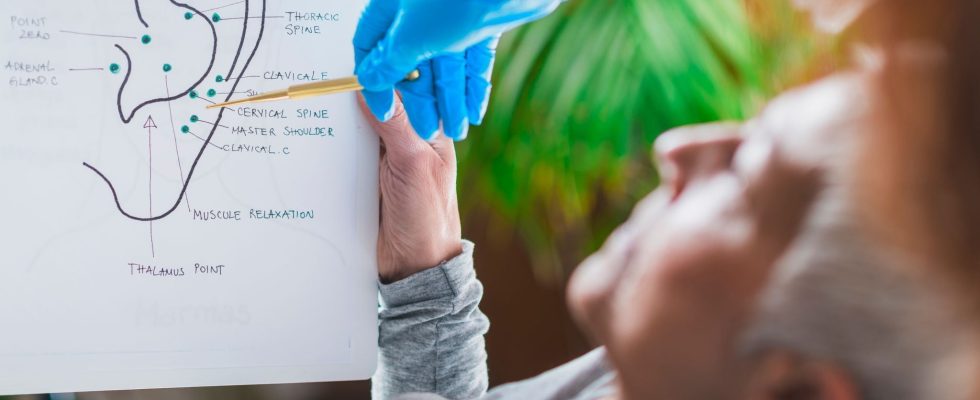The inventor of auriculotherapy is the Frenchman Paul Nogier (1908-1996), born in Lyon, where he studied engineering and then medicine. His therapy is based on the hypothesis that the human outer ear is an area where the entire body is projected. By stimulating specific points, therapists could influence the health and functioning of internal organs and other parts of the body.
Auriculotherapy is enjoying surprising success, particularly in France, but not only. The program of scientific diploma in auriculotherapy from the University of Paris, for example, is a complete 152-hour course. The “11th international auriculotherapy symposium” took place in September this year in Copenhagen and was announced with the following statement: “The number of people diagnosed with psychological disorders such as depression, anxiety, functional disorders and post-stress syndrome -traumatic is on the rise worldwide. Auriculotherapy is an effective method, generally without side effects, which can be practiced as an alternative or complementary medicine to all therapies in the field of psychology.
While a young doctor, Nogier noticed that some of his patients had a scar on their ear and learned that an alternative therapist, Madame Barrin of Marseille, had cauterized a certain point on the ear (later called the Barrin point) in the belief that this would relieve the symptoms of sciatica in patients. Nogier was intrigued: after inserting needles there, his sciatica patients seemed to see their pain ease. If one area of the ear could be stimulated to relieve their symptoms, he wondered if other areas could be used to treat other parts of the body.
The ear would correspond to an upside down fetus
Nogier quickly noticed that the “Barrin point cauterization technique” only worked for sciatica and not for hip, knee, or shoulder pain. He concluded that Barrin’s point on the ear corresponds to the lumbosacral area where the sciatic nerve leaves the spinal canal. “Could the protruding part of the ear, the antihelix, correspond to the spine?” Nogier wondered. It did not take long for him to discover that the outer ear had exceptional reflex properties and that each point on the pinna of the ear was linked to a specific part of the body. He ends up convincing himself that the human body is in some way “drawn on the ear”: the lobule, at the bottom of the ear, corresponds to the head; the conch, in the center, corresponds to the thorax and abdomen; and the cartilaginous part, the antihelix, corresponds to the vertebral column.
To identify the crucial points, Nogier used an electronic device that would have measured skin conductivity. He thus managed to develop a detailed diagram of the ear. Nogier became convinced that 1) the ear is “energetically” linked to other parts and organs of the body, 2) the ear corresponds to an upside-down fetus, 3) by stimulating the right point of the ear, it can treat problems of the corresponding body part, 4) specific frequencies have specific effects on the body, 5) through ear diagnosis, it can identify a whole series of chronic diseases.
Nogier’s concepts have been widely accepted in the field of alternative medicine, but they have been ridiculed by scientists because they do not correspond to our knowledge of anatomy and physiology. The various maps used by proponents of auriculotherapy reveal some uncomfortable disagreements. In other words, the hypotheses of auriculotherapy lack plausibility.
Little good quality data
Today, however, auricular therapy is touted as a panacea, a treatment for most conditions. One of the first rigorous tests of Auricular Therapy was published in 1984 by one of the most eminent pain researchers, Ronald Melzack. He concluded that “auriculotherapy is not an effective therapeutic procedure for chronic pain.” In the meantime, an abundance of clinical trials has emerged. Their results are confusing and far from uniform. It is therefore preferable not to rely on isolated studies, but on systematic analyzes which include the results of all reliable trials.
One of these reviews concluded that “due to the paucity and poor quality of data, the evidence for the effectiveness of auricular therapy for the symptomatic treatment of insomnia are limited”. An in-depth assessment of the evidence entitled “Evaluation of the effectiveness of auriculotherapy practice” was carried out by Inserm at the request of the French Ministry of Health in 2013. It failed to demonstrate the superior therapeutic effect of auriculotherapy compared to placebo for most of the claimed indications. Other authors arrive at more positive conclusions; however, due to the often poor quality of primary studies, they must be interpreted with caution. lots of caution.
Auricular acupuncture is often recommended to combat the bothersome symptom of dry mouth (xerostomia) that can occur after cancer treatment. Yet the evidence for its effectiveness beyond the placebo effect is weak to say the least. The most authoritative evaluation of existing trials of acupuncture of the ear and other sites concluded that “the available evidence is insufficient to conclude that acupuncture is an evidence-based treatment option for xerostomia/ hyposalivation.
Contrary to what supporters of the treatment try to make people believe, auriculotherapy is not completely devoid of risks. The most commonly reported side effects are local skin irritation and discomfort, mild tenderness or pain, and dizziness. Most of these effects are transient, mild and tolerable. Unfortunately, that doesn’t mean that ear therapists don’t do harm. Every time they advocate their therapy as an alternative to effective treatment of a serious condition, they endanger the health and even the lives of their patients.
.
